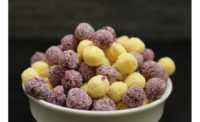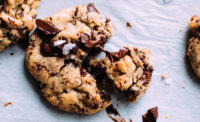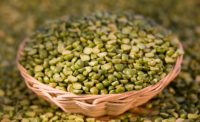Sugar is a great friend to food. It is the combination of taste and function that makes sugar a staple in baking. It can be regular, extra-fine, coarse or granulated. It can be light or dark, brown or white, liquid or powdered. The many forms of sugar contribute to its versatility. Functionally, sugar improves elasticity in gluten development, provides color and flavor through caramelization when heated, stabilizes whipped egg foam, facilitates leavening when used with yeast, provides bulk and stability, and helps custards and cakes “set” and sauces thicken. Without it, chocolate just wouldn’t taste the same.
Is it any wonder why we have a love affair with sugar?
Unfortunately, this affinity can sometimes have an unfortunate flip side. It is possible to have too much of a good thing. Americans’ overindulgence in general, along with lack of exercise, has led to more of us growing overweight, sometimes to unhealthy degrees. According to statistics released by the Centers for Disease Control and Prevention (CDC), about one-third of the U.S. adult population is obese and almost 18 percent of children are obese. Diabetes is on the rise. The American Diabetes Association reports that in 2012, 29 percent of the population had diabetes, an increase from the 2010 level of 25.8 percent.
Public-health advocates have worked to raise awareness of our declining health. The result was a backlash against sugar. Consumers heard the message and started cutting back on sugar. John Rupp, senior marketing analyst, Ingredion Inc., Westchester, IL, shared data from the 2015 “Food & Health Survey” by the International Food Information Council, including findings that more than half (55 percent) of all Americans are now doing something to take control of the healthfulness of their diet, and 66 percent of consumers ages 18–34 cite healthfulness as a driver of food and beverage purchases. This includes 50 percent of respondents who stated a desire to limit or avoid sugars.
Despite trying to avoid sugar, we can’t get away from it. It’s a great ingredient. According to Steven Young, principal, Steven Young Worldwide, Houston, “Sugar still is the gold standard from several perspectives—quality of sweetness, functional value, sensory characteristics.” Sugar provides sweetness with a clean flavor with no aftertaste. Its numerous functional benefits are hard to replicate at a similar cost. And sugar is a friendly, easy-to-recognize ingredient, which fits in with the clean-label movement.
Naturally sweet
For some consumers who have soured on sugar, honey comes close to sugar’s ability to deliver on sweetness. And, in a sea of mystifying food ingredients, seeing “honey” on the label, is reassuring. It’s familiar and natural. Catherine Barry, marketing director, National Honey Board, Firestone, CO, notes, “The beauty of honey is that it’s not ‘the next big thing.’” There is a positive halo around honey in the minds of consumers.
Barry also notes that honey’s popularity is increasing because it’s a sweetener that meets consumer demands and provides manufacturers with a clean-label ingredient that delivers “countless functional and flavor benefits, like improved mouthfeel, improved color and anti-staling. Adding honey to a product automatically makes the product seem premium in the minds of consumers.” Using a varietal honey flavor like orange blossom can provide an added dimension of interest from both a flavor and labeling perspective.
Other natural sugars derived from fruit sources, such as crystalline grape sugars, provide options. “These grape-derived sugars enhance the natural fruit flavor in products like fruit pies, fruit snack cakes and biscuits with fruit pieces,” according to Tonya Lofgren, sales and marketing coordinator, Ciranda Inc., Hudson, WI. “They provide superior moisture retention compared to sucrose to help maintain freshness.” The products, including Crystal DextroGrape, Crystal FructoGrape and Crystal SweetGrape, contribute to the Maillard reaction in a similar way to sucrose for nice browning.
Nutritive sweeteners like honey, fructose, dextrose, glucose, high fructose corn syrup and sugar bring calories to the formulation. Non-nutritive sweeteners, notes Young, are so intense in sweetness that they do not deliver calories in the amount required for the same level of sweetness as a nutritive sweetener. Non-nutritive sweeteners can be either natural or artificial. He notes that if sugar has a benchmark sweetness of one, aspartame is 200, “meaning it’s 200 times as sweet as sugar.” Sucralose is 600 times as sweet as sugar, neotame is 8,000, and advantame is 20,000.
“Many of these high-intensity sweeteners have off-flavors when used at too high of a level, which is why sometimes combining low levels of several different sweeteners can help formulators achieve their sweetness goals,” says Young. “No single non-nutritive sweetener can deliver everything you need it to do when replacing sugar, especially in baking.” Combining non-nutritive sweeteners with other ingredients can build back the functionality lost by the absence of sugar.
“When looking for natural sweeteners, fructose and coconut palm sugar are good choices for clean-label sugar-reduction because they are derived from plants,” says Thom King, president, Steviva Ingredients, Portland, OR. “Both pair well with stevia, improve upfront sweetness and address the issue of browning. We have introduced CocoSweet, which is composed of coconut sugar and high-grade, water-extracted stevia. CocoSweet is designed for sweet baked goods such as cookies and biscuits. In addition to its pleasing flavor, coconut sugar has a glycemic index of 35.” A combination of fructose and stevia, Fructevia, is also available.
“Stevia sweeteners are highly sought after natural, zero-calorie sweeteners,” says Scott Fabro, global product development director, high intensity sweeteners, Cargill Inc., Minneapolis. “However, broader use is constrained by their taste at high usage levels, which can be bitter or have an after-taste. Certain stevia sweetener molecules such as Reb D and Reb M do not have this problem, but because they make up less than 1 percent of the plant’s leaf, they are prohibitively expensive to obtain from the stevia plant. Cargill’s Eversweet sweetener is made through fermentation. This removes the cost constraints, allowing food and beverage producers to create a new class of lower-calorie products that taste great and are affordable.”
Afrouz Naeini, senior marketing manager, Ingredion Inc., Westchester, IL, notes, “The sweetener toolbox is expanding with the introduction of new stevia-based sweeteners, sweetness-modulation technology, simple sources of sweetness—syrups, fruits, vegetables—and the introduction of rare sugars.”
Rare and sweet
Rare sugars exist in very small quantities in nature. Astrea allulose is one of only approximately 50 rare sugars, notes Yuma Tani, R&D deputy manager, Matsutani Chemical Industry Co. Ltd., Itami, Japan. Astrea allulose is low in calories and can act as a reduced-calorie sugar substitute in baked goods. “Astrea allulose has similar physiochemical properties of sugar, such as browning,” he says. “However, Astrea allulose doesn’t raise blood glucose levels, and actually attenuates blood glucose and insulin secretion if consumed with sugars or other carbohydrate sources. It is a match for people with diabetes.”
Sweetness alone cannot win over a baked good consumer. Texture is also an important driver of liking. Ami Krishan, category marketing director, sweeteners, Tate & Lyle, Decatur, IL, points to analysis of the top 10 food and beverage trends for 2015 put forth by Innova Market Insights. “Texture claims on new product launches increased 36 percent from 2010 to 2013,” she says, citing the findings. “The same report found that bakery and snacks were among the top five categories for texture claims.”
So the challenge to formulators is to maintain or improve texture while reducing sugar. To address this challenge, Tate & Lyle introduced DOLCIA PRIMA allulose in February 2015. “DOLCIA PRIMA allulose provides the same functional benefits as sucrose, such as bulk, humectancy and browning during baking,” says Krishan.
Fiber can also factor into this equation. “We’ve noticed that more manufacturers are looking to create baked goods and snacks that have added functional ingredients like fiber,” says Stefanie Lee, applications scientist, Tate & Lyle. “We’ve been working with several large baked-goods producers to help them decrease sugar and calories and increase fiber in products like brownies, cakes, muffins and snack bars. We have been successful using our toolbox of ingredients, including DOLCIA PRIMA allulose, PROMITOR soluable corn fiber and TASTEVA stevia.”
Sweetener suppliers understand that replacing sugar, in whole or in part, can be difficult for formulators. Several companies have developed processes to take some of the guesswork out of formulation and support sensory evaluation. Ingredion, for example, developed two processes: Dial-in Texture and Dial-in Sweetness, to reduce time spent on benchtop development. They also have created Sweetabulary, described by Naeini as a tool to “help quantify how consumers feel about specific sweet tastes to provide their customers with clear and actionable formulation steps. This tool helps formulators and marketers work together to achieve the set of functional, taste and texture attributes that consumers prefer.”
As consumer demand for sugar reduction continues, so will the development of sugar alternatives. The sweetener toolbox will continue to grow. For those overwhelmed by too many choices, developing good working relationships with key suppliers will be an essential aspect of finding the right sweetener solution for snacks and baked goods.






